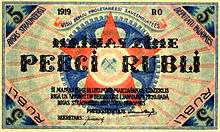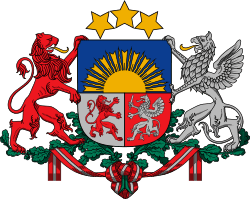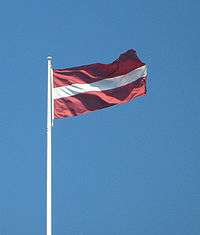Latvian Socialist Soviet Republic
| Latvian Socialist Soviet Republic | ||||||||||||||
| Latvijas Sociālistiskā Padomju Republika | ||||||||||||||
| ||||||||||||||
| ||||||||||||||
| Motto "Visu zemju proletārieši, savienojieties!" Workers of the world, unite! | ||||||||||||||
| Anthem Internacionāle | ||||||||||||||
| Capital | Riga (to 22 May 1919) Dvinsk (Daugavpils) Rezhitsa (Rezekne) | |||||||||||||
| Languages | Latvian · Russian Latgaliana | |||||||||||||
| Government | Socialist republic | |||||||||||||
| Chairman | ||||||||||||||
| • | 1918–1920 | Pēteris Stučka | ||||||||||||
| Legislature | All-Latvian Congress of Workers' Soviet Deputies | |||||||||||||
| History | ||||||||||||||
| • | Established | 17 December 1918 | ||||||||||||
| • | Recognized by Russian SFSR | 22 December 1918 | ||||||||||||
| • | Riga captured by German Freikorps | 22 May 1919 | ||||||||||||
| • | Disestablished | 13 January 1920 | ||||||||||||
| Currency | Ruble | |||||||||||||
| ||||||||||||||
| a. | Local languages included German, Yiddish, Lithuanian and Estonian.[1] | |||||||||||||
The Latvian Socialist Soviet Republic (Latvian: Latvijas Sociālistiskā Padomju Republika, LSPR) was a short-lived socialist republic formed during the Latvian War of Independence. It was proclaimed on 17 December 1918 with the political, economic, and military backing of Vladimir Lenin and his Bolshevik government in the Russian SFSR. The head of government was Pēteris Stučka.
History
The LSPR armed forces, which consisted of the Red Latvian Riflemen and other units of the Red Army, quickly captured most of the territory of present-day Latvia, forcing Kārlis Ulmanis's provisional government into a small pocket of territory around the city of Liepāja.
Stučka's government introduced sweeping communist reforms, resuming the radical policy direction from the abortive Iskolat regime. Some reforms were initially popular, such as the expropriation of property from the bourgeoisie. The decision to unilaterally nationalise all agrarian land, however, had dire economic consequences for the cities, as rural support for the regime declined drastically.
The peasants no longer agreed to supply the townsfolk with foodstuffs on the government's terms, and shortages became critical. When the people in Riga and other cities began to starve, contributing to widespread discontent among the proletariat as well, a wave of terror swept both rural and urban areas, seeking out alleged counter-revolutionaries supposedly responsible for the failures of the regime. Arbitrary Revolutionary Tribunals and the so-called Flintenweiber ("Gun-Women") were memorable components of this wave of terror.
When the Entente-backed Ulmanis government counter-attacked with the backing of German Freikorps units in the spring of 1919, they quickly regained the lost territory. The capital, Riga, was recaptured on 22 May 1919, and the territory of the LSPR was reduced to a part of Latgale in eastern Latvia, until the final defeat in the Battle of Daugavpils by combined Latvian and Polish forces in early 1920.
After the Soviet occupation of Latvia in 1940 the official historians began to claim, that Soviet power has been re-established in Latvia, and the 1920 - 1940 period of Independence was viewed just as a temporary break in the Soviet power.
.jpg) May 1, 1919 celebrations in Riga
May 1, 1919 celebrations in Riga.jpg) May 1, 1919 decorations in Riga
May 1, 1919 decorations in Riga 5 ruble note
5 ruble note 1 ruble note
1 ruble note
See also
- Iskolat
- Commune of the Working People of Estonia
- Finnish Democratic Republic
- History of Latvia
- Lithuanian–Byelorussian Soviet Socialist Republic
- Republics of the Soviet Union
- Socialist Soviet Republic of Byelorussia
References
Bibliography
- Stuchka, P. (1919–21). Piat’ mesiatsev Sotsialisticheskoi sovetskoi Latvii: Sbornik statei i dokumentov (in Russian). Pskov: Izd-vo TsK KP Latvii. pp. 2 v. OCLC 38770737.
- Popoff, George (1932). The City of the Red Plague: Soviet Rule in a Baltic Town. London; New York: George Allen & Unwin; E.P. Dutton & Co. OCLC 413467.
- Krastyn', IA. P. (Krastiņš, J.) (ed.) (1959–60). Sotsialisticheskaia Sovetskaia Respublika Latvii v 1919 g. i inostrannaia interventsiia: Dokumenty i materialy (in Russian and Latvian). Riga: Izd-vo Akademii Nauk Latviiskoi SSR. pp. 2 v. OCLC 18861284.
- Zile, Zigurds L. (1977). "Legal Thought and the Formation of Law and Legal Institutions in the Socialist Soviet Republic of Latvia, 1917–1920" (PDF). Journal of Baltic Studies. 8 (3): 195–204. doi:10.1080/01629777700000191. Retrieved 2007-07-10.
External links
- Latvia in the Soviet Union (early flags)
- Latvia at www.worldstatesmen.org.
- (Latvian) Significant documents from the history of the LSPR at historia.lv.
.svg.png)
.svg.png)

